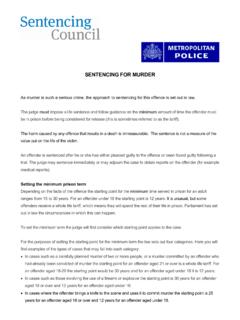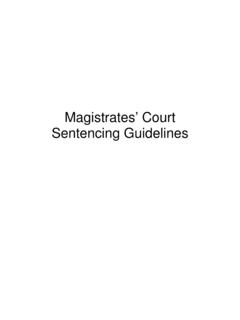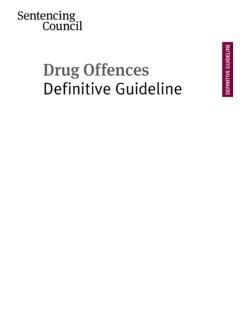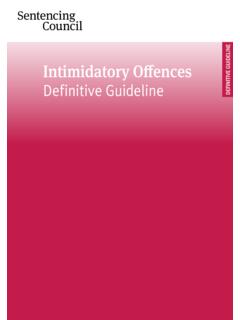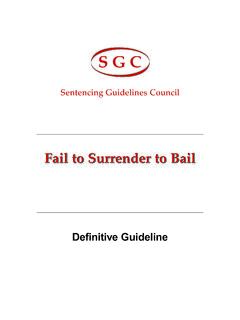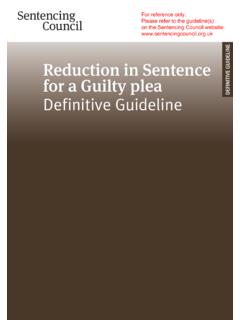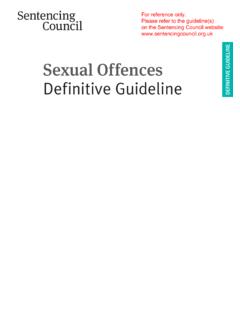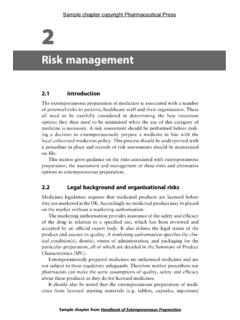Transcription of Health and Safety Offences, Corporate Manslaughter and ...
1 For reference only. Please refer to the guideline(s). on the Sentencing Council website: DEFINITIVE GUIDELINE. Health and Safety Offences, Corporate Manslaughter and Food Safety and Hygiene Offences Definitive Guideline For reference only. Please refer to the guideline(s). Contents on the Sentencing Council website: Applicability of guidelines 2. Health and Safety Organisations 3. Breach of duty of employer towards employees and non-employees Breach of duty of self-employed to others Health and Safety at Work Act 1974 (section 33(1)(a) for breaches of sections 2 and 3). Breach of Health and Safety regulations Health and Safety at Work Act 1974 (section 33(1)(c)). Health and Safety Individuals 13. Breach of duty of employer towards employees and non-employees Breach of duty of self-employed to others Breach of duty of employees at work Health and Safety at Work Act 1974 (section 33(1)(a) for breaches of sections 2, 3 and 7). Breach of Health and Safety regulations Health and Safety at Work Act 1974 (section 33(1)(c)).
2 Secondary Liability Health and Safety at Work Act 1974 (sections 36 and 37(1) for breaches of sections 2 and 3. and section 33(1)(c)). Corporate Manslaughter 21. Corporate Manslaughter and Corporate homicide Act 2007 (section 1). Breach of food Safety and food hygiene regulations Organisations 29. England Food Safety and Hygiene (England) Regulations 2013 (regulation 19(1)). Wales Food Hygiene (Wales) Regulations 2006 (regulation 17(1)). The General Food Regulations 2004 (regulation 4). Breach of food Safety and food hygiene regulations Individuals 39. England Food Safety and Hygiene (England) Regulations 2013 (regulation 19(1)). Wales Food Hygiene (Wales) Regulations 2006 (regulation 17(1)). The General Food Regulations 2004 (regulation 4). Annex: Fine bands and community orders 47. Crown copyright 2015. This publication is licensed under the terms of the Open Government Licence except where otherwise stated. To view this licence, visit or write to the Information Policy Team, The National Archives, Kew, London TW9 4DU, or email: Where we have identified any third party copyright information you will need to obtain permission from the copyright holders concerned.
3 Effective from 1 February 2016. For reference 2 Health and Safety Offences, Corporate Manslaughter and Food Safety and Hygiene only. Offences Definitive Guideline Please refer to the guideline(s). on the Sentencing Council website: Applicability of guidelines I. n accordance with section 120 of the Structure, ranges and starting points Coroners and Justice Act 2009, the Sentencing For the purposes of section 125(3) (4) of the Council issues this definitive guideline. Coroners and Justice Act 2009, the guideline It applies to all organisations and offenders specifies offence ranges the range of sentences aged 18 and older, who are sentenced on or appropriate for each type of offence. Within each after 1 February 2016, regardless of the date offence, the Council has specified a number of the offence. of categories which reflect varying degrees of seriousness. The offence range is split into category Section 125(1) of the Coroners and Justice Act 2009 ranges sentences appropriate for each level provides that when sentencing offences committed of seriousness.
4 The Council has also identified a after 6 April 2010: starting point within each category. Every court Starting points define the position within a category range from which to start calculating the (a) must, in sentencing an offender, follow any provisional sentence. The court should consider sentencing guidelines which are relevant to the further features of the offence or the offender that offender's case, and warrant adjustment of the sentence within the range, including the aggravating and mitigating (b) must, in exercising any other function relating factors set out at step two. In this guideline, if the to the sentencing of offenders, follow any proposed sentence is a fine, having identified a sentencing guidelines which are relevant to the provisional sentence within the range at step two exercise of the function, the court is required to consider a further set of factors that may require a final adjustment to the unless the court is satisfied that it would be sentence.
5 Starting points and ranges apply to all contrary to the interests of justice to do so. offenders, whether they have pleaded guilty or been convicted after trial. Credit for a guilty plea is For individuals, this guideline applies only to taken into consideration only after the appropriate offenders aged 18 and older. General principles sentence has been identified. to be considered in the sentencing of youths are in the Sentencing Guidelines Council's definitive Information on fine bands and community orders is guideline, Overarching Principles Sentencing set out in the annex at pages 47 and 48. Youths. Effective from 1 February 2016. Forandreference Health and Safety Offences, Corporate Manslaughter and Food Safety only. Hygiene Offences Definitive Guideline 3. Please refer to the guideline(s). on the Sentencing Council website: Organisations Health AND Safety ORGANISATIONS. Breach of duty of employer towards employees and non-employees Breach of duty of self-employed to others Health and Safety at Work Act 1974 (section 33(1)(a) for breaches of sections 2 and 3).
6 Breach of Health and Safety regulations Health and Safety at Work Act 1974 (section 33(1)(c)). Triable either way Maximum: when tried on indictment: unlimited fine when tried summarily: unlimited fine Offence range: 50 fine 10 million fine Effective from 1 February 2016. For reference 4 Health and Safety Offences, Corporate Manslaughter and Food Safety and Hygiene only. Offences Definitive Guideline Please refer to the guideline(s). STEP ONE on the Sentencing Council website: Determining the offence category The court should determine the offence category using only the culpability and harm factors in the tables Health AND Safety ORGANISATIONS. below. Culpability Where there are factors present in the case that fall in different categories of culpability, the court should balance these factors to reach a fair assessment of the offender's culpability. Very high Deliberate breach of or flagrant disregard for the law High Offender fell far short of the appropriate standard; for example, by: failing to put in place measures that are recognised standards in the industry ignoring concerns raised by employees or others failing to make appropriate changes following prior incident(s) exposing risks to Health and Safety allowing breaches to subsist over a long period of time Serious and/or systemic failure within the organisation to address risks to Health and Safety Medium Offender fell short of the appropriate standard in a manner that falls between descriptions in high' and low' culpability categories Systems were in place but these were not sufficiently adhered to or implemented Low Offender did not fall far short of the appropriate standard.
7 For example, because: significant efforts were made to address the risk although they were inadequate on this occasion there was no warning/circumstance indicating a risk to Health and Safety Failings were minor and occurred as an isolated incident See page 5. Effective from 1 February 2016. Forandreference Health and Safety Offences, Corporate Manslaughter and Food Safety only. Hygiene Offences Definitive Guideline 5. Please refer to the guideline(s). Harm on the Sentencing Council website: Health and Safety offences are concerned with failures to risks to Health and Safety and do not require proof that the offence caused any actual harm. The offence is in creating a risk of harm. 1) Use the table below to identify an initial harm category based on the risk of harm created by the Health AND Safety ORGANISATIONS. offence. The assessment of harm requires a consideration of both: the seriousness of the harm risked (A, B or C) by the offender's breach; and the likelihood of that harm arising (high, medium or low).
8 Seriousness of harm risked Level A Level B Level C. Death Physical or mental impairment, not All other cases not Physical or mental amounting to Level A, which has falling within Level A. impairment resulting in a substantial and long-term effect or Level B. lifelong dependency on third on the sufferer's ability to carry out normal day-to-day activities or on party care for basic needs their ability to return to work Significantly reduced life A progressive, permanent or expectancy irreversible condition High likelihood Harm category 1 Harm category 2 Harm category 3. of harm Medium Harm category 2 Harm category 3 Harm category 4. likelihood of harm Low likelihood Harm category 4 (start Harm category 3 Harm category 4. of harm towards bottom of range). 2) Next, the court must consider if the following factors apply. These two factors should be considered in the round in assigning the final harm category. i) Whether the offence exposed a number of workers or members of the public to the risk of harm.
9 The greater the number of people, the greater the risk of harm. ii) Whether the offence was a significant cause of actual harm. Consider whether the offender's breach was a significant cause* of actual harm and the extent to which other factors contributed to the harm caused. Actions of victims are unlikely to be considered contributory events for sentencing purposes. Offenders are required to protect workers or others who may be neglectful of their own Safety in a way which is reasonably foreseeable. If one or both of these factors apply the court must consider either moving up a harm category or substantially moving up within the category range at step two overleaf. If already in harm category 1 and wishing to move higher, move up from the starting point at step two on the following pages. The court should not move up a harm category if actual harm was caused but to a lesser degree than the harm that was risked, as identified on the scale of seriousness above.
10 * A significant cause is one which more than minimally, negligibly or trivially contributed to the outcome. It does not have to be the sole or principal cause. Effective from 1 February 2016. For reference 6 Health and Safety Offences, Corporate Manslaughter and Food Safety and Hygiene only. Offences Definitive Guideline Please refer to the guideline(s). STEP TWO on the Sentencing Council website: Starting point and category range Having determined the offence category, the court should identify the relevant table for the offender on Health AND Safety ORGANISATIONS. the following pages. There are tables for different sized organisations. At step two, the court is required to focus on the organisation's annual turnover or equivalent to reach a starting point for a fine. The court should then consider further adjustment within the category range for aggravating and mitigating features. At step three, the court may be required to refer to other financial factors listed below to ensure that the proposed fine is proportionate.
